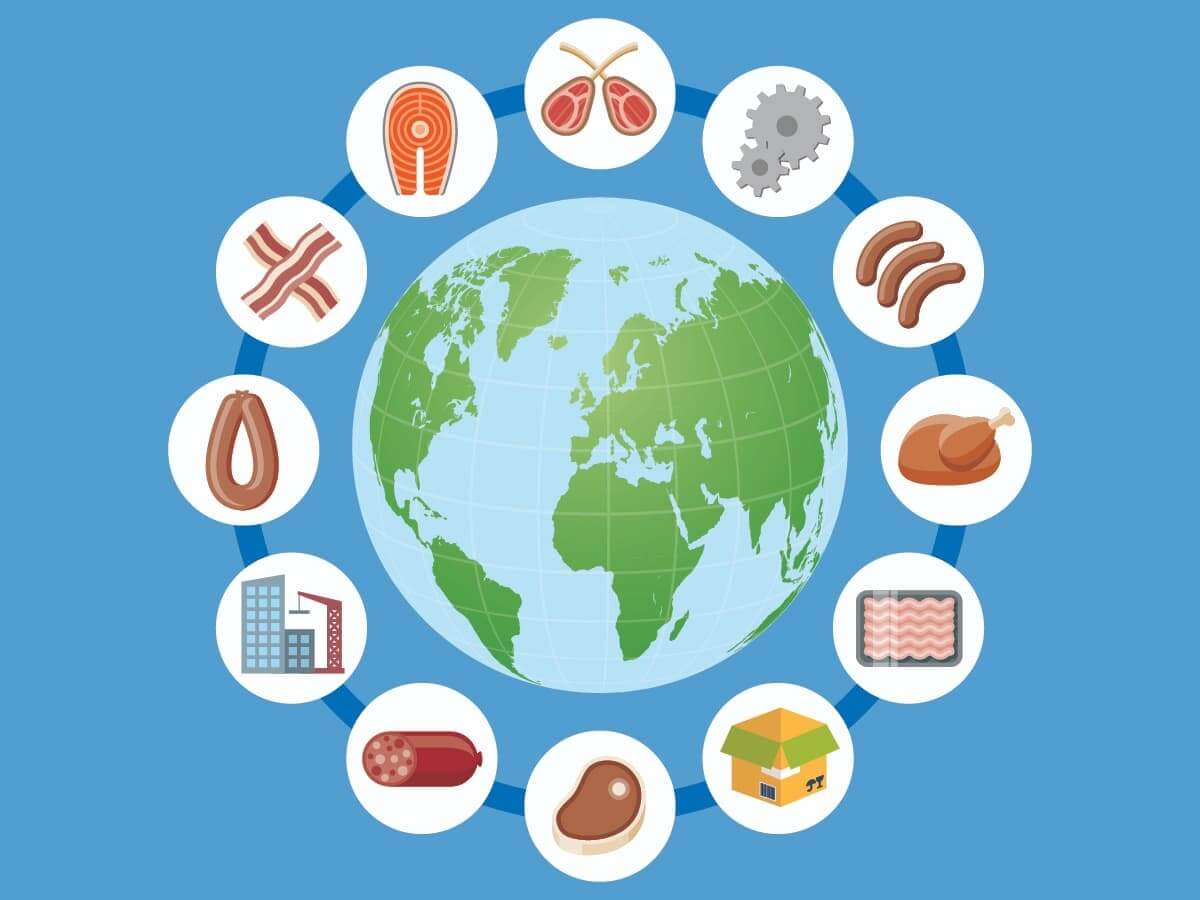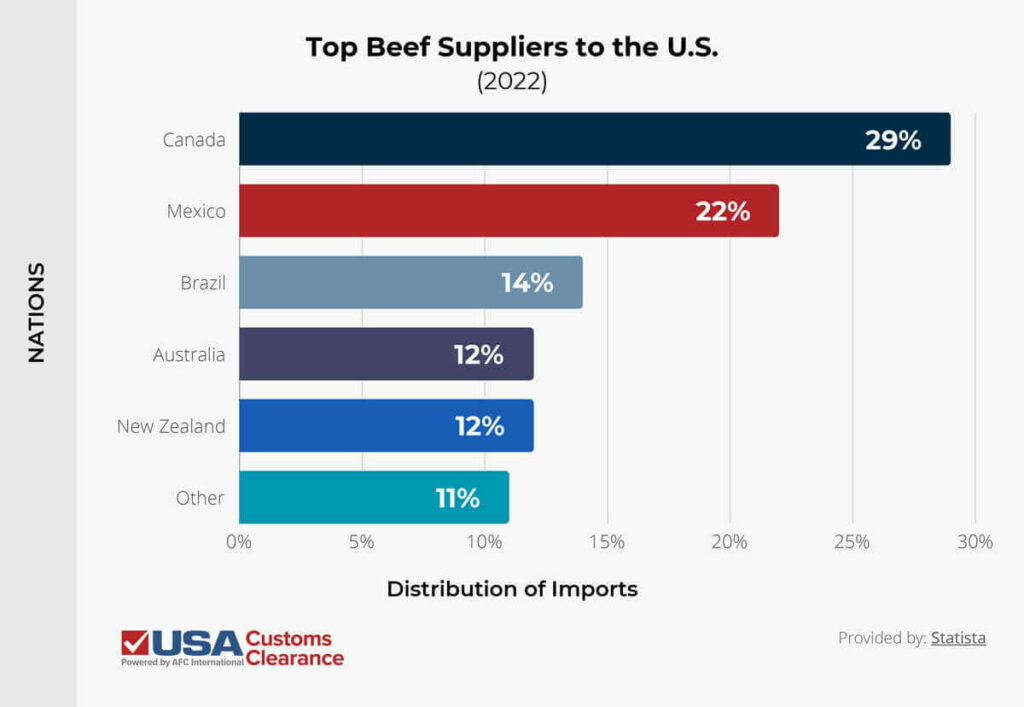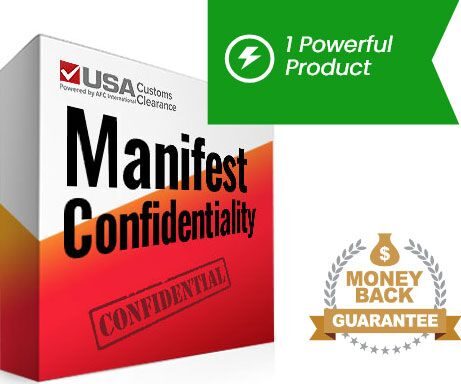
Meat is one of the most imported agricultural products in the United States. However, getting these goods into the country is no easy task to undertake. If you want to import meat, you’ll need to satisfy a variety of requirements.
Key Takeaways:
The regulations for animal products are complex, but in this guide, I’ll go over all the rules you’ll need to follow.
The primary federal agencies that regulate animal products meant for human consumption are the Food and Drug Administration (FDA) and United States Department of Agriculture (USDA). There are two sub-agencies under USDA that enforce these regulations.
This includes:
Customs and Border Protection (CBP) also plays a limited role in regulating the entry of these goods into the country.
The FDA wants your animal goods to meet the same safety standards that are applied to foods produced domestically. To ensure this happens, you’ll need to follow a few of their requirements.
This includes:
I’ll walk you through each of these regulations and show you what you’ll need to do.
Most facilities that manufacture, process, pack, receive, or hold meat must register with the FDA. Therefore, you’ll need to determine if your suppliers are already registered with the FDA and ensure they have an active food facility registration number. If they do, you won’t need to worry about completing this step.
However, you will need to register your supplier through the FDA Industry Systems portal if they’re not already established. During this process, you’ll have to complete 12 different steps where you will provide vital information about their facility.
This includes:
You’ll need to re-register all your supplier’s facilities with the FDA every two years.

FSMA has numerous rules in place to guarantee the safety of foods produced domestically and abroad. Under this law, you’ll be required to follow the Foreign Supplier Verification Program (FSVP).
You’ll have the responsibility of determining if your supplier has the right precautions in place to ensure the meat they produce is safe for consumption. To abide by the FSVP, you’ll need to follow five steps.
This includes:
For the hazard analysis, you’ll be required to identify and evaluate the various hazards that your products could face.
This may include:
These dangers could occur naturally, unintentionally, or intentionally be introduced for economic gain. When conducting your analysis, you’ll need to carefully assess the probability that hazards could occur.
You’ll need to consider the following factors:
Next, you’ll need to evaluate the risks that can arise when you buy your goods and review your supplier’s performance.
Factors that you’ll need to evaluate, include:
The third step you’ll have to complete is verifying your supplier. This will ensure your items are coming from an approved provider of these products. Fortunately, there are multiple ways that you can verify the supplier of your goods.
It’s essential you know what corrective actions to take if the supplier doesn’t follow the right processes to ensure the safety of your products. What action you will take can vary based on the circumstances, but it could include ceasing to use the supplier until they adequately address noncompliance.
The final rule you’ll need to follow is providing some key pieces of information about yourself for each line entry that enters the country.
This includes:
If you don’t have a UFI, you can use a Data Universal Numbering System (DUNS) as an acceptable replacement.
Meat products have to abide by the FDA’s labeling requirements to verify the safety and nutritional value of the goods. The label for these items must contain informative and truthful details about your products.
The language used on the label should be in English or the predominant language of the U.S. territory where your goods will arrive. There are five essential pieces of information that should be included on the label.
The statement of identity will verify the type of meat and its common name. Net quantity of contents is used to list how much of the product is contained in the packaging by weight or volume. Ingredients should be listed in descending order based on their weight.
Nutrition facts will contain the following:
If your goods contain any major food allergens, you will need to provide a label that indicates which are present in your product.
Before your products can be brought into the U.S., you’ll have to send a prior notice (PN) to the FDA. This lets FDA know to target inspections or examinations of food products coming into the country.
You can submit the document using CBP’s Automated Commercial Environment (ACE) or FDA’s Prior Notice System Interface (PNSI). Creation of a PN is done by completing a series of steps. When completing this documentation through the PNSI, you’ll be providing a variety of different information.
This includes:
After you’ve filled out all essential information, you’ll need to save your work.
Related: The Complete Guide To FDA Customs Clearance

We work with you every step of the way to ensure a smooth and stress-free customs experience.
The USDA is responsible for regulating meat, poultry, processed egg products, and catfish. As a result, they want to ensure that your goods are safe for consumption.
FSIS is an agency within the USDA that enforces a variety of procedures that you’ll have to follow.
I’ll show you how these procedures work in the subsequent sections.
All foods derived from animals entering the country should have an FSIS foreign inspection certificate accompanying it. This document will need different pieces of information regarding your product.
This includes:
The foreign inspection certificate will need an official seal from the foreign government that performed the inspection. A signature from an agency official should also appear on the document. Certificates should be written in English and the language of the foreign country where you purchased your products.
FSIS officials will reinspect your products before they can be allowed into the country. The appearance and condition of the items in your shipment will be inspected during a visual inspection. Officials will also ensure that your goods have an FSIS certification and label.
Once your items pass FSIS reinspection, they’ll be allowed into the U.S. and treated the same as domestic products. Approved goods will also be given a USDA mark of inspection, unless your products are from Canada.
All meat originating from Canada will have the Canadian mark of inspection and export stamp. If your items are rejected during FSIS reinspection, the container carrying them will be stamped with the statement: “U.S. Refused Entry”.
If this happens, you’ll need to take the following actions within 45 days:
Keep in mind that you’ll only be allowed to convert your rejected goods into animal food if your request for diversion has been granted by the FDA.
FSIS will randomly sample products to determine if they have violative chemical residues outlined by the National Residue Program. They also perform a variety of microbial tests for different types of meat.
Both residue and microbial testing is done in accordance with domestic testing procedures.
There are strict labeling requirements for importing meat into the U.S. that are enforced by the FSIS. These rules govern the content and appearance of your goods and poultry products, as well as usage instructions and best practices.
FSIS must approve everything from the date and handling instructions, to the size of the font on the label. This ensures consumers can make informed choices on safe products. All meat and poultry products sold in the U.S. must comply with the labeling requirements.
Every label must include:
You’ll only need to include safe handling instructions if they’re applicable to your items.
Related: Importing Organic Food into the U.S.
APHIS Veterinary Services (VS) is part of the USDA and they enforce numerous requirements for meat products. They’ll want you to obtain a VS import permit for your products. You can submit and track these documents using APHIS eFile.
If you’re bringing meat into the country for the first time, the VS Permitting Assistant will help you when applying for your permit by taking you through a series of steps.
Completing these steps will help you if you need a permit and what actions you’ll have to take to get one. APHIS will require you to submit a Lacey Act Declaration for your items to ACE.
This can be done by using the APHIS Core Message Set system. APHIS has plenty of instructional videos that will take you through the steps on how to submit your declaration through this program. You can also contact one of our Licensed Customs Brokers for further assistance
Consulting CTA
CBP’s requirements for the entry of these goods into the U.S. essentially reinforce the ones set by the USDA and FDA. They explicitly stress the importance of submitting a PN to FDA and obtaining approval from USDA to bring your goods into the country.
You can’t purchase meat from any country, but you can buy these products from 33 nations that have USDA approval. They also provide information on certified establishments in each nation that are eligible to export these goods to the United States. The U.S. purchases a variety of these items from the approved countries.
However, beef is the most popular meat product that comes into the country from abroad. Of the 33 approved nations, I’ve provided data on the top five countries that supply this product to the United States.

In the following sections, I’ll discuss why these countries make the U.S.’s top five suppliers for these products.
The United States-Mexico-Canada Agreement (USMCA) is a big reason why U.S. buyers purchase animal products from these two countries. The free trade agreement (FTA) provides numerous benefits.
This includes:
Buyers in the U.S. purchase a variety of meat products from Canada and Mexico, but beef is the most popular. All agricultural products, including animal foods for human consumption, are given duty-free treatment under USMCA. This means you’ll be able to save money when you buy these goods from Mexico or Canada.
Related: Import Costs from Mexico
The U.S. and Brazil don’t share an FTA. However, both countries signed the Agreement on Trade and Economic Cooperation to enhance their relations. Similar to Mexico and Canada, the U.S. buys a large amount of beef from Brazil.
In the first three months of 2022, the U.S. purchased 50,000 metric tons of beef from Brazil. Part of the reason Brazil is a popular place to source these products from is due to the country’s devalued currency.
Australia and the U.S. both share an FTA that provides duty-free treatment on three quarters of agricultural tariff lines. Fortunately, preferential treatment extends to a variety of meat the U.S. purchases from this vital trade partner.
This includes:
The U.S. mostly purchases beef products from Australia, but it also buys large quantities of lamb. In 2022, Australia shipped 92,566 tons of lamb products to the United States. New Zealand is another popular supplier of meat.
Although an FTA doesn’t exist between the U.S. and New Zealand, both countries share excellent trade relations with one another. The country is also well known for providing quality animal products.
On April 10th, 2025, the U.S. implemented a 10% tariff on beef imports from a variety of countries. Many of the affected nations include the ones we’ve already discussed.
To make matters worse, the new 10% tariff circumvents the duty-free treatment provided by FTAs. As a result, importing beef from the affected countries will be considerably more expensive.
If you need assistance with importing beef or want access to the most recent information, then schedule a consulting session with one of our Licensed Customs Brokers. You can also call our team at (855) 912-0406 for further assistance.
Game meat refers to flesh from animals found in the wild, rather than those raised on farms. The FDA classifies these items as non-amenable. They require imports of this to abide by the same regulations as other meat items, which we’ve already discussed.
Another non-amenable product is bushmeat. This typically comes from animals located in jungle, savannah, and wetland environments. Bushmeat is illegal to bring into the U.S., per the Centers for Disease Control (CDC). Any shipments of this animal product that arrive at a U.S. port of entry will be destroyed.
Navigating through all the regulations set by federal agencies that have jurisdiction over meat products can be hard to do on your own. USA Customs Clearance can guide you through the requirements you need to complete. Our team consists of Licensed Customs Brokers and import specialists that have years of knowledge that you can trust.
You can also use one of our valuable services:
With USA Customs Clearance, your success is a guarantee. Get started with one of our great services or contact us through the site if you have any questions or concerns. You can also reach our team at (855) 912-0406.

Your Shipping Manifest is Public and Available To Your Competitors.
Purchase Manifest Confidentiality and Protect Your Business and Supply Chain!
 Copy URL to Clipboard
Copy URL to Clipboard

Google is changing how it surfaces content. Prioritize our high-quality guides and industry-leading coverage in search results by setting usacustomsclearance.com as a preferred source.
How about salted lamb tail from Mongolia.
How can I import to USA in small quantities.
Is there a way to import foreign military rations from Europe and Eastern Europe for personal use only, without being subject to customs taking items from the package? These rations are not for resale or distribution. They are a hobby.
I want to import the buff dried meat and homey from nepal. what would be the process.
I want to export beef, goat, and lamb from either Kenya, Ethiopia or Tanzania to the US. Do any of these countries have FSIS agreements with USA?
To Whom it may Concern,
I produce beef jerky in Argentina but have had issues shipping to the US.
I'm now expanding into Malaysia and was wondering if exporting my jerky to the US is and easier?
I have the list for appoved importers of beef from Argentina. Is it similar for Malaysia?
I thank you for any clarification regarding this matter you can provide.
Tim Stroud
Is it possible to import pork products into the US from the Philippines?
Can a Zimbabwean company export biltong (beef jerky) to the U.S. and what procedures does the Zimbabwean company has to follow? (FDA registration, FSIS, and etc.)
Not sure where this is the place to ask but anyway; we would like to import process sauce product into US. But, there's a beef ingredient which takes about 10% of total ingredient. Do we any special permits to import these sauce to US ? If no special permits is needed to what percentage can I import without the permits ?
what documents required when importing meat from EU ?
Hi Paul,
I am looking to start an import company from the ground up to bring in red meat and poultry from Brazil into the US. Both frozen and dry form preferably. Would like to have an initial conversation on the initial steps needed to get things off the ground here before heading to Brazil in the fall. Thank You
Hello,
I would like to import meat from Argentina.
What would you recommend?
Routes, permits, etc?
Can Iraqi Lamb be exported to USA ?
Hi, looking to export dryed beef from Mexico (Beef jerky). Anu help on this? Thank you
Hi Randy,
Can an Indian company export buffalo and/or chicken jerky to the US?
Hello,Can a pakistan company export frozen chicken meat and frozen beaf and frozen goat meat to america even by acquiring FDA registration and following FSIS regulations.thanks.
Looking to get a national brand beef jerky from Australia sent to the usa. What route would I need to do to avoid customs from taking it. Thank u
This is Alan Li with RTW Logistics, freight forwarder for export/import.
My customer just loaded one reefer of frozen beef from Hamada, Japan and shipment’s ETA port Everglades, FL late August.
Since this is their first frozen beef, they an Import Customs Broker in Florida.
Can we discuss first and I will provide the importer’s contact info?
Thanks
Can a Thai company export beef jerky to the U.S. and what procedures does Thai company has to follow? (FDA registration, FSIS, and etc.)
Hi Paul,
A company out of Thailand can export beef jerky to the U.S. There will be many steps to go through to complete your first import including FDA registration as you mentioned. One of our import experts will reach out to you shortly to assist you further. We look forward to working with you!